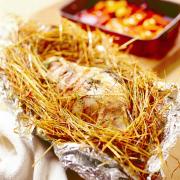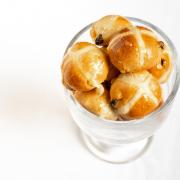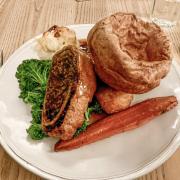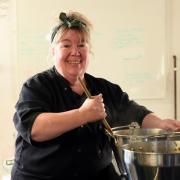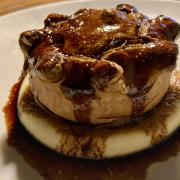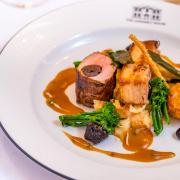Norfolk magazine Home Chef of the Year 2018 Mark Fitch with this summer’s hottest cooking trend, the home pizza oven

This month, I’m travelling the eight or so yards from my back door to my outdoor pizza oven. I’ve had mine around five years. It arrived in three very heavy sections and I had a friendly builder on hand to fabricate the oven base and surround, which for me, includes some wood storage below and a very important pizza making area to the side. So, if you’re thinking of acquiring a pizza oven this summer, or if you are having a few teething problems, or even if you wanted to try something different with your indoor oven pizza cooking, here are my tips for a better end result.
The fire...
For the first year or so, I followed the apparently usual, tried and tested formula of making your fire on one side of the oven and then moving the burning logs (kiln dried) to the other side and baking your pizza where the fire had been.

Now, I make my fire in the middle, predominantly out of more thinly chopped wood, and then when it’s roaring (this takes around 15 minutes), I push the burning logs to the back and sides, thus producing my ‘horseshoe of fire...’ This allows for a more even bake and it’s easier to manoeuvre your pizza as it’s right in front of you.
The dough...
I suggest using your favourite bread recipe – I follow that of the son of an Essex publican who done good – but increase the yeast by half again, or if you’re feeling lockdown crazy, double it. And include some semolina flour in your mix. Let it rise (magnificently) for an hour in a warm place before bashing it back, then separate it into your pizza dough balls and let them fluff up for another 20 minutes or so before you head to the oven.
The base...
I fry a chopped onion, two garlic cloves and three or so jarred peppers for 10 minutes on a low to medium heat and then add a tin of chopped tomatoes, a tablespoon of sun-dried tomato purée, a glass of red wine, oregano, half a tablespoon of sugar, juice of half a lemon and a splash of balsamic vinegar. Season. Let it boil down somewhat and then whizz with a hand-held blender. I suggest you reduce it before you blend – reducing the sauce once blended is a bit spitty. You can make this up earlier in the day.
The cheese...
Grated mozzarella and cheddar (2:1 ratio) with added fresh mozzarella (squeeze that moisture out) and some shavings of Parmesan. Oh, and a creamy blue if you like that. As with the other toppings, have them grated/sliced ready. With the heat you will be working with, things are going to get a bit hairy.
The final prep...
So, you’ve got your horseshoe of fire screaming for something to incinerate, your sauce in a pan or jug (with a ladle sat in it), your cheeses on hand and your toppings also nearby. And one of those living basil pots.
Now if you take one thing from this article, this is it. Semolina (not the aforementioned flour, but the tiny grains) is your friend.
It’s better than that. It’s your long lost Italian lover. It saves you when you think you’ve fouled up. It lubricates everything – prep area, pizza paddle, oven floor – yes, outdoor pizza cooking is sexy. It gives your dough a crisp crunch that you thought only the professional chefs could achieve.
Toss it everywhere. Under where you roll out your pizza (pretty much as thin as you can), on your paddle, in the oven (although if you throw it too close to the horseshoe of fire, it will ignite). Immerse yourself in its wonderful pizza-making properties.
One more thing. Leave the middle (just a couple of inches diameter) of your pizza as free of toppings as you can; and certainly no fresh mozzarella. Your pizza will cook so quickly that the middle, on top, doesn’t quite get the heat it needs, compared to everywhere else. Keeping it clear prevents a slightly soggy middle.
If you like seafood, you’ll love this...
The cooking...
Take your paddle (the thin metal type), trust in the semolina, and be brave. One swift thrust under your made-up pizza and you will be ready to deposit in the oven. Again, once in position inside the oven, remove the paddle speedily and you’re nearly there. Two points to mention. The above manoeuvring will be so much easier if your pizza is smaller than or the same size as your paddle. If it’s larger, the edges will flop over the sides and it will get messy. Also, once in the oven, leave it for 30 seconds before touching it, by which time the bottom will have crisped up enough for you to move it round.
Remember, as effective as the horseshoe is, it is no Ring of Fire. So some active wrist twisting (that’s my best attempt at describing it... it will come to you, I promise) is needed; and with that, you will be able to turn your nearly done pizza.
Withdraw slightly so you can toss on some basil leaves without burning your hand and pop back in for another minute or so. Hopefully, all the cheese will melt before the edges start smoking.
Continuity...
One downside of the horseshoe of fire is that as you are using thinner pieces of wood, they burn more quickly. So it is important to add one or two handily placed logettes to the back and each side of your fire between every two pizzas cooked.
If you loose the momentum, the pizzas take ages (which sometimes at least gives you a second to snatch a glug of beer or a slice your favourite waiter/waitress/general assistant has left for you).
I have managed to cater for up to 20. Normally, we have four to eight people over, and if you get it right, it’s a real show-stopping crowd pleaser.
Your co-host (or appointed assistant) will be nearly as busy as you, ferrying the wooden boards back and forth. Keep them on their toes. Even shout at them – using an Italian accent allows you to get away with most things...
When your guests start getting full, one or two of them may ask you ‘for a go.’ Always suck in a big breath (like tradesmen quoting on the spot) and give a little shake of the head with the words, ‘it’s not quite as easy as it looks...’ Then it’s up to you.
I hope that by the time you read this, you have stayed and still are staying safe. Where I am at this moment in time, next month could see me writing about a tour of my fondue kit – it’s there somewhere.










